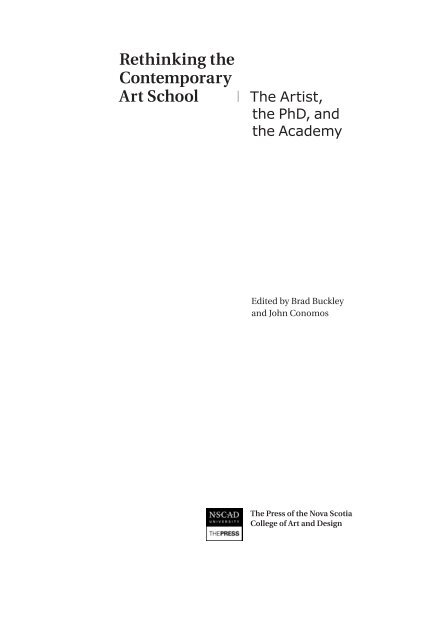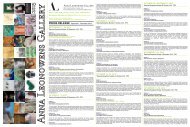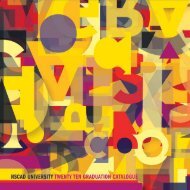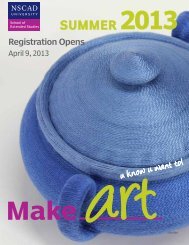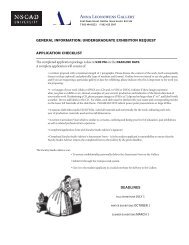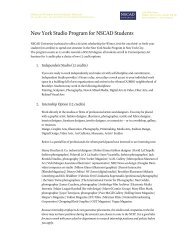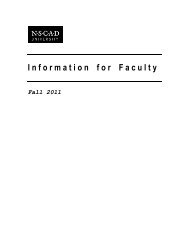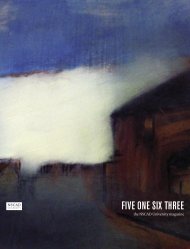Rethinking the Contemporary Art School - Nova Scotia College of ...
Rethinking the Contemporary Art School - Nova Scotia College of ...
Rethinking the Contemporary Art School - Nova Scotia College of ...
You also want an ePaper? Increase the reach of your titles
YUMPU automatically turns print PDFs into web optimized ePapers that Google loves.
<strong>Rethinking</strong> <strong>the</strong><br />
<strong>Contemporary</strong><br />
<strong>Art</strong> <strong>School</strong> | The <strong>Art</strong>ist,<br />
<strong>the</strong> PhD, and<br />
<strong>the</strong> Academy<br />
Edited by Brad Buckley<br />
and John Conomos<br />
The Press <strong>of</strong> <strong>the</strong> <strong>Nova</strong> <strong>Scotia</strong><br />
<strong>College</strong> <strong>of</strong> <strong>Art</strong> and Design
The Press <strong>of</strong> <strong>the</strong> <strong>Nova</strong> <strong>Scotia</strong> <strong>College</strong><br />
<strong>of</strong> <strong>Art</strong> and Design<br />
5163 Duke Street<br />
Halifax <strong>Nova</strong> <strong>Scotia</strong> Canada B3J 3J6<br />
The Press <strong>of</strong> <strong>the</strong> <strong>Nova</strong> <strong>Scotia</strong> <strong>College</strong> <strong>of</strong> <strong>Art</strong> and Design gratefully acknowledges <strong>the</strong> law<br />
firm McInnes Cooper for providing a sustaining operations grant for 2008-2011.<br />
© 2009 Brad Buckley, John Conomos, The Press <strong>of</strong> <strong>the</strong> <strong>Nova</strong> <strong>Scotia</strong> <strong>College</strong> <strong>of</strong> <strong>Art</strong> and<br />
Design, and <strong>the</strong> authors.<br />
All rights reserved. No part <strong>of</strong> this publication may be reproduced, stored in a retrieval<br />
system, or transmitted, in any form or by any means, without <strong>the</strong> prior permission in<br />
writing <strong>of</strong> The Press <strong>of</strong> <strong>the</strong> <strong>Nova</strong> <strong>Scotia</strong> <strong>College</strong> <strong>of</strong> <strong>Art</strong> and Design, or as expressly permitted<br />
by law, or under terms agreed with <strong>the</strong> appropriate reprographic rights organizations.<br />
Enquires concerning reproduction outside <strong>the</strong> scope <strong>of</strong> <strong>the</strong> above should be sent<br />
to The Press <strong>of</strong> <strong>the</strong> <strong>Nova</strong> <strong>Scotia</strong> <strong>College</strong> <strong>of</strong> <strong>Art</strong> and Design at <strong>the</strong> address above.<br />
The authors and publisher are grateful to all those individuals and organizations who<br />
have granted permission to reproduce images. Every effort has been made to obtain<br />
permission to use copyrighted material in this volume; <strong>the</strong> publisher apologizes for any<br />
errors or omissions and would welcome <strong>the</strong>se being brought to <strong>the</strong>ir attention.<br />
Editorial Director: Susan McEachern<br />
Manager: Christopher McFarlane<br />
Copy Editor: Ulrike Walker<br />
Graphic Design: <strong>Art</strong>hur Carter, AustenHouse<br />
Front cover photo: Chris Reardon<br />
Inside cover photo: Cathy Busby<br />
Printed and bound in Canada<br />
Available through D.A.P./Distributed <strong>Art</strong> Publishers<br />
155 Sixth Avenue, 2nd Floor, New York, NY 10013<br />
Tel (212) 627-1999 Fax (212) 627-9484<br />
Library and Archives Canada Cataloguing in Publication<br />
<strong>Rethinking</strong> <strong>the</strong> contemporary art school : <strong>the</strong> artist, <strong>the</strong> PhD, and <strong>the</strong><br />
academy / edited by Brad Buckley and John Conomos.<br />
Includes bibliographical references and index.<br />
ISBN 978-0-919616-49-3<br />
1. <strong>Art</strong>—Study and teaching (Higher). 2. <strong>Art</strong> schools. 3. Educational<br />
innovations. I. Buckley, Brad, 1952- II. Conomos, John III. Title: <strong>Art</strong>ist,<br />
<strong>the</strong> PhD, and <strong>the</strong> academy.<br />
N345.R48 2009 700.71’1 C2009-90247
Contents<br />
| Acknowledgments viii<br />
Foreword | Susan McEachern 1<br />
Introduction | Brad Buckley and John Conomos 2<br />
Chapter One | Su Baker<br />
<strong>Art</strong> <strong>School</strong> 2.0: <strong>Art</strong> <strong>School</strong>s in <strong>the</strong> Information Age<br />
or Reciprocal Relations and <strong>the</strong> <strong>Art</strong> <strong>of</strong> <strong>the</strong> Possible 27<br />
Chapter Two | Bruce Barber<br />
The Question (<strong>of</strong> Failure) in <strong>Art</strong> Research 45<br />
Chapter Three | Mikkel Bogh<br />
Borderlands: The <strong>Art</strong> <strong>School</strong> Between <strong>the</strong> Academy<br />
and Higher Education 64<br />
Chapter Four | Brad Buckley<br />
What is with <strong>the</strong> Ceiling! The <strong>Art</strong>ist, Higher Degrees,<br />
and Research in <strong>the</strong> University <strong>Art</strong> <strong>School</strong> 76<br />
Chapter Five | Brad Buckley and John Conomos<br />
The Australian Research Council Funding Model<br />
Condemns <strong>Art</strong> <strong>School</strong>s to a Bleak Future 87<br />
Chapter Six | Juli Carson and Bruce Yonemoto<br />
Curriculum and Practice in <strong>the</strong> Age <strong>of</strong> Post-Studio<br />
<strong>Art</strong> Production 90<br />
Chapter Seven | Edward Colless<br />
Unnameable 101<br />
Chapter Eight | John Conomos<br />
<strong>Art</strong>, <strong>the</strong> Moving Image, and <strong>the</strong> Academy 106<br />
Chapter Nine | Jay Coogan<br />
Evolutionary Forces: Advancing <strong>Art</strong> and Design<br />
Education 121
Chapter Ten | Luc Courchesne<br />
<strong>Art</strong>, Design, and Beyond 136<br />
Chapter Eleven | Sara Diamond<br />
Moving Out <strong>of</strong> Bounds: Expanding <strong>the</strong> Field<br />
<strong>of</strong> <strong>Art</strong> Education 145<br />
Chapter Twelve | Lauren Ewing<br />
Remixing <strong>the</strong> Hive 159<br />
Chapter Thirteen | Gary Pearson<br />
The Outskirts <strong>of</strong> Town: A Peripheral Centre for <strong>Art</strong>,<br />
Agency, and Academia 164<br />
Chapter Fourteen | Bill Seaman<br />
Combinatoric Micro-Strategies for Emergent<br />
Transdisciplinary Education 182<br />
Chapter Fifteen | Jeremy Welsh<br />
Transitions, Dialogues, Interruptions, Pregnant<br />
Pauses, and Leaps into The Void: Recent Experiences<br />
in Norwegian Higher <strong>Art</strong> Education 206<br />
| Notes on Contributors 215<br />
| Notes on Cover <strong>Art</strong>work 218<br />
| Index 221
Juli Carson and | Curriculum and<br />
Bruce Yonemoto Practice in <strong>the</strong><br />
Age <strong>of</strong> Post-Studio<br />
<strong>Art</strong> Production<br />
| Part One: On dialectics and reversals<br />
[There is a debate that] has not advanced beyond <strong>the</strong> monotonous<br />
reiteration <strong>of</strong> arguments for and against: on <strong>the</strong> one hand, <strong>the</strong> correct<br />
political line is demanded <strong>of</strong> <strong>the</strong> poet; on <strong>the</strong> o<strong>the</strong>r, it is justifiable to<br />
expect his work to have quality. Such a formulation between <strong>the</strong> two<br />
factors, political and quality, has not been perceived. Of course, <strong>the</strong><br />
connection can be asserted dogmatically. You can declare: a work that<br />
shows <strong>the</strong> correct political tendency need show no o<strong>the</strong>r quality. You<br />
can also declare: a work that exhibits <strong>the</strong> correct tendency must <strong>of</strong> ne-<br />
cessity have every o<strong>the</strong>r quality.<br />
Chapter Six<br />
Walter Benjamin, “Author as Producer.” 1<br />
In his 1934 address to <strong>the</strong> Institute for <strong>the</strong> Study <strong>of</strong> Fascism in Paris, Walter<br />
Benjamin argued across a polemic <strong>the</strong>n debated by <strong>the</strong> Left. Simply stated:<br />
Must artists be politically committed? Or can <strong>the</strong>y be left to experiment with<br />
<strong>the</strong>ir own formal devices? Is this even an accurate polemic? Benjamin concluded<br />
that nei<strong>the</strong>r position was true alone. He thus gave us <strong>the</strong> famous axiom,<br />
which became central to a branch <strong>of</strong> critical contemporary art practice: <strong>the</strong><br />
tendency <strong>of</strong> a literary work can only be politically correct if it is also literarily<br />
correct. Which is to say, <strong>the</strong> politically correct tendency includes a literary tendency.<br />
2 Since <strong>the</strong> political cannot be disentangled from <strong>the</strong> aes<strong>the</strong>tic because<br />
it is through aes<strong>the</strong>tics that <strong>the</strong> political presents itself, for an artist to be politically<br />
committed s/he has to maintain a high level <strong>of</strong> aes<strong>the</strong>tic competency.<br />
In Benjamin’s time, <strong>the</strong> Left’s debate was a question <strong>of</strong> political commitment<br />
versus cultural literacy. Today it has been reinvented as cultural <strong>the</strong>ory versus<br />
aes<strong>the</strong>tic disciplinarity. And in some cases, as <strong>the</strong> debate progresses, <strong>the</strong> term<br />
“interdisciplinarity” has been collapsed with “cultural <strong>the</strong>ory,” so that an even<br />
more specific question <strong>of</strong> interdisciplinarity versus disciplinarity has emerged.<br />
As in Benjamin’s times, this is a false polemic.<br />
Deep skepticism <strong>of</strong> High Modernist disciplinarity—what New Yorkers called<br />
“reductivism”—defined <strong>the</strong> 1980s “post-studio” school <strong>of</strong> art. Even so, <strong>the</strong> pioneers<br />
<strong>of</strong> this international school—Daniel Buren, Michael Asher, Hans Haacke,
Juli Carson and Bruce Yonemoto | 91<br />
Marcel Broodthaers, Adrian Piper, Yvonne Rainer, Mary Kelly, and Dan Graham,<br />
to name a few—provided models for practice that were equally robust on two<br />
fronts: <strong>the</strong>y knew <strong>the</strong> history <strong>of</strong> modernist aes<strong>the</strong>tics and combined this with<br />
broader cultural <strong>the</strong>ories that defined post-structuralist discourse. Since <strong>the</strong>n,<br />
for those <strong>of</strong> us who have inherited <strong>the</strong> post-studio legacy, <strong>the</strong> (art) baby has increasingly<br />
been thrown out with <strong>the</strong> bathwater. The result is <strong>the</strong> ironic proliferation<br />
<strong>of</strong> “interdisciplinarity” without any disciplines. In many <strong>of</strong> today’s contemporary<br />
art schools <strong>the</strong> cultural memory <strong>of</strong> twentieth-century modernism—its<br />
concerns and formal languages—have thus been tossed into <strong>the</strong> dustbin <strong>of</strong> history<br />
through <strong>the</strong> overdetermination <strong>of</strong> Conceptualism’s critique <strong>of</strong> High Modernism.<br />
As a means <strong>of</strong> pedagogical intervention, we are interested in a model<br />
<strong>of</strong> Conceptualism—in film and in art—that is at once informed by <strong>the</strong> legacy <strong>of</strong><br />
modernist production and mindful <strong>of</strong> modernism’s blind spots. Moreover, it is<br />
to cultural critique that this aes<strong>the</strong>tic knowledge must be directed.<br />
The problem with over determining <strong>the</strong> cultural side <strong>of</strong> <strong>the</strong> aforementioned<br />
axis—resulting in identity politics, cultural <strong>the</strong>ory’s privileged genre—is that it<br />
tends to privilege an artist’s collusion with what Althusser called an ideological<br />
identification with a mass cultural image that “interpellates” (or hails) him or<br />
her into its service. This places <strong>the</strong> artist in <strong>the</strong> position <strong>of</strong> a consumer ra<strong>the</strong>r<br />
than a producer <strong>of</strong> mass culture, <strong>the</strong> latter usurping <strong>the</strong> place <strong>of</strong> art history as<br />
<strong>the</strong> source <strong>of</strong> a work’s form/content. In her essay “Welcome to <strong>the</strong> Cultural Revolution,”<br />
Rosalind Krauss similarly noted:<br />
This is <strong>the</strong> shift that Cultural Studies has operated away from an earlier,<br />
and what is now seen as outmoded, focus on <strong>the</strong> “production” <strong>of</strong> texts<br />
or works <strong>of</strong> art (as <strong>the</strong> goal <strong>of</strong> an equally outmoded literary or art-<br />
historical analysis), in favor <strong>of</strong> a new concentration on “reception,” or in<br />
<strong>the</strong> mass-cultural context addressed by Cultural Studies, that form <strong>of</strong><br />
reception which is more properly called “consumption.” 3<br />
In <strong>the</strong> context <strong>of</strong> cultural critique, this state <strong>of</strong> affairs is problematic because<br />
when debates over a work’s aes<strong>the</strong>tic production are completely cut out, one<br />
ends up going <strong>the</strong> cultural studies route alone. And that route always begins<br />
with <strong>the</strong> idea—usually <strong>the</strong> consumption <strong>of</strong> a cultural event—that passes straight<br />
through production, delivering a regurgitated subject for mass consumption<br />
once again. In its most dubious form, this was <strong>the</strong> problem with Nicholas Bourriaud’s<br />
culture-based model <strong>of</strong> relational aes<strong>the</strong>tics. Practitioners <strong>of</strong> this model<br />
include Rirkrit Tiravanija, who organizes a dinner in a collector’s home and<br />
leaves him all <strong>the</strong> ingredients to make a Thai soup. Or Philippe Parreno, who<br />
invites people to engage <strong>the</strong>ir favorite hobbies on May Day, on a factory assembly<br />
line. Or Vanessa Beecr<strong>of</strong>t, who “dresses some twenty women in <strong>the</strong> same<br />
way, complete with a red wig, and <strong>the</strong> visitor merely gets a glimpse <strong>of</strong> <strong>the</strong>m<br />
through <strong>the</strong> doorway.” Or Christine Hill, who “works as a check-out assistant<br />
in a supermarket” and “organizes a weekly gym workshop in a gallery.” 4 The list<br />
goes on. But what unites <strong>the</strong>se works is <strong>the</strong> presence <strong>of</strong> a given service that <strong>the</strong>
92 | <strong>Rethinking</strong> <strong>the</strong> <strong>Contemporary</strong> <strong>Art</strong> <strong>School</strong><br />
artist has displaced into a new situation, one that is <strong>the</strong>n given to <strong>the</strong> “viewer”<br />
to be reconsumed.<br />
Ano<strong>the</strong>r problem with <strong>the</strong> cultural <strong>the</strong>ory (relational aes<strong>the</strong>tics) model is<br />
that it enacts a simple dialectical reversal <strong>of</strong> Kantian modernist studio practice,<br />
one that was founded on <strong>the</strong> notion <strong>of</strong> artistic “genius.” Dialectical reversals, as<br />
a reversal <strong>of</strong> terms, have long been <strong>the</strong> most flat-footed mode <strong>of</strong> critique because<br />
<strong>the</strong> move does not challenge <strong>the</strong> meaning <strong>of</strong> conventional terms within<br />
a given system. Ra<strong>the</strong>r, <strong>the</strong> move reorganizes and reweights such terms, allowing<br />
<strong>the</strong> ideological associations attending <strong>the</strong>m to continue. For instance, in<br />
<strong>the</strong> case <strong>of</strong> Kantian aes<strong>the</strong>tics: “Genius is <strong>the</strong> talent (natural endowment) which<br />
gives <strong>the</strong> rule to art. Since talent, as an innate productive faculty <strong>of</strong> <strong>the</strong> artist,<br />
belongs itself to nature, we may put it this way: Genius is <strong>the</strong> innate mental<br />
aptitude nature gives <strong>the</strong> rule to art” [emphasis added]. 5 And since aes<strong>the</strong>tic genius<br />
was innate, it could only be honed—not taught—within <strong>the</strong> artist’s studio.<br />
Such was Clement Greenberg’s vision <strong>of</strong> High Modernist painting against which<br />
<strong>the</strong> Conceptualists, who innovated <strong>the</strong> “post-studio” school, rallied. However,<br />
<strong>the</strong> Conceptualists did not give up on production; from <strong>the</strong>ir vantage point,<br />
<strong>the</strong> “studio” was only a metaphor for Greenberg’s Kantian interiority model for<br />
art production. And since it wasn’t a literal space, it wasn’t readily dispensed<br />
with. Ra<strong>the</strong>r it was reinvented along with <strong>the</strong> very notion <strong>of</strong> modernist aes<strong>the</strong>tics<br />
at <strong>the</strong> limits <strong>of</strong> object production. Relational aes<strong>the</strong>tics, however, dispenses<br />
entirely with studio production reversing and re-weighting <strong>the</strong> terms “studio”<br />
versus “exhibition.” Again, in this model we march straight past production towards<br />
consumption.<br />
There has to be a better way to sift through <strong>the</strong>se modernist strategies towards<br />
a model <strong>of</strong> critical aes<strong>the</strong>tics. And <strong>the</strong>re is. This is what we are building in<br />
<strong>the</strong> Studio <strong>Art</strong> Program at UCI.<br />
| Part Two: Modernist legacies and critical aes<strong>the</strong>tics<br />
Historicism contents itself with establishing a causal connection be-<br />
tween various moments in history. But no fact that is a cause is for that<br />
very reason historical. It became historical posthumously, as it were,<br />
through events that may be separated from it by thousands <strong>of</strong> years.<br />
A historian who takes this as his point <strong>of</strong> departure stops telling <strong>the</strong><br />
sequence <strong>of</strong> events like <strong>the</strong> beads <strong>of</strong> a rosary. Instead, he grasps <strong>the</strong><br />
constellation which his own era has formed with a definite earlier one.<br />
Walter Benjamin, “Theses on <strong>the</strong> Philosophy <strong>of</strong> History” 6<br />
In non-canonical accounts <strong>of</strong> twentieth-century art and <strong>the</strong>ory, <strong>the</strong> very practice<br />
<strong>of</strong> modernism is so heterogeneous as to throw contemporary labels like<br />
“postmodernism” into question. Just which modernism is postmodernism<br />
“post” to? In a North American context, from which we write, <strong>the</strong> closest syn-
| Notes on Contributors<br />
Notes on Contributors | 215<br />
Su Baker is associate pr<strong>of</strong>essor and head <strong>of</strong> <strong>the</strong> <strong>School</strong> <strong>of</strong> <strong>Art</strong>, Victorian <strong>College</strong><br />
<strong>of</strong> <strong>the</strong> <strong>Art</strong>s, <strong>the</strong> University <strong>of</strong> Melbourne. She is a graduate <strong>of</strong> Sydney <strong>College</strong> <strong>of</strong><br />
<strong>the</strong> <strong>Art</strong>s, <strong>the</strong> University <strong>of</strong> Sydney, and Curtin University <strong>of</strong> Technology. Baker<br />
has exhibited over <strong>the</strong> last twenty years in museums and survey shows at numerous<br />
venues, including <strong>the</strong> <strong>Art</strong>ists’ Museum, Poland, and <strong>the</strong> <strong>Art</strong> Gallery <strong>of</strong><br />
New South Wales. Baker is represented by John Buckley Gallery in Melbourne<br />
and Gallery Dusseldorf in Perth.<br />
Bruce Barber is a pr<strong>of</strong>essor at NSCAD University and directs <strong>the</strong> MFA program<br />
<strong>the</strong>re. His artwork, exhibited internationally since 1971, is documented in Reading<br />
Rooms (1992). He is <strong>the</strong> editor <strong>of</strong> Essays on Performance and Cultural Politicization<br />
and Conceptual <strong>Art</strong>: The NSCAD Connection. Barber co-edited Voices <strong>of</strong><br />
Fire: <strong>Art</strong> Rage, Power, and <strong>the</strong> State and is editor <strong>of</strong> Condé and Beveridge: Class<br />
Works (2008). He is also <strong>the</strong> author <strong>of</strong> Performance [Performance] and Performers:<br />
Essays and Conversations (2008), edited by Marc Léger.<br />
Mikkel Bogh is pr<strong>of</strong>essor and rector <strong>of</strong> <strong>the</strong> <strong>School</strong>s <strong>of</strong> Visual <strong>Art</strong>s at <strong>the</strong> Royal<br />
Danish Academy <strong>of</strong> Fine <strong>Art</strong>s. Between 1995 and 2000, he was associated with<br />
<strong>the</strong> Department <strong>of</strong> Literature and <strong>the</strong> Department <strong>of</strong> <strong>Art</strong>s and Cultural Studies<br />
at Copenhagen University. In 2000 he became a lecturer in modern culture at<br />
<strong>the</strong> University and later became head <strong>of</strong> <strong>the</strong> Department <strong>of</strong> <strong>Art</strong>s and Cultural<br />
Studies. He is an art historian and critic, publishing widely on art education and<br />
on Western art and culture from <strong>the</strong> seventeenth century to <strong>the</strong> present. His<br />
most recent publication is Per Bak Jensen: The Unseen Image (2006).<br />
Brad Buckley is associate pr<strong>of</strong>essor and director <strong>of</strong> <strong>the</strong> Sydney <strong>College</strong> <strong>of</strong> <strong>the</strong><br />
<strong>Art</strong>s Graduate <strong>School</strong> at <strong>the</strong> University <strong>of</strong> Sydney. He was educated at St Martin’s<br />
<strong>School</strong> <strong>of</strong> <strong>Art</strong>, London, and <strong>the</strong> Rhode Island <strong>School</strong> <strong>of</strong> Design. He is coeditor,<br />
with John Conomos, <strong>of</strong> Republics <strong>of</strong> Ideas (2001) and has also developed<br />
and chaired with Conomos a number <strong>of</strong> conference sessions for <strong>the</strong> <strong>College</strong><br />
<strong>Art</strong> Association, including America: <strong>the</strong> Divine Empire (Atlanta 2005) and<br />
The <strong>Contemporary</strong> Collaborator in an Interdisciplinary World (Dallas 2008).<br />
Buckley’s work has been shown internationally for over two decades.<br />
Juli Carson is an associate pr<strong>of</strong>essor in <strong>the</strong> Studio <strong>Art</strong> Department at <strong>the</strong> University<br />
<strong>of</strong> California, Irvine, where she teaches critical and curatorial practice<br />
in contemporary art and directs <strong>the</strong> University <strong>Art</strong> Gallery. She is also editor <strong>of</strong><br />
Exile <strong>of</strong> <strong>the</strong> Imaginary: Politics, Aes<strong>the</strong>tics, Love (2008). Her forthcoming book,<br />
The Conceptual Unconscious, will be published by Les Figues Press.
216 | <strong>Rethinking</strong> <strong>the</strong> <strong>Contemporary</strong> <strong>Art</strong> <strong>School</strong><br />
Edward Colless is head <strong>of</strong> Critical and Theoretical Studies at <strong>the</strong> Victorian <strong>College</strong><br />
<strong>of</strong> <strong>the</strong> <strong>Art</strong>s, <strong>the</strong> University <strong>of</strong> Melbourne. He has taught art history, film<br />
studies, and performance in a variety <strong>of</strong> tertiary institutions. Colless’s critical<br />
writing has been widely published in journals, catalogues, and books, within<br />
Australia and internationally. He is <strong>the</strong> author <strong>of</strong> The Error <strong>of</strong> My Ways (1995)<br />
and has also worked as an architectural assistant, graphic artist, curator, <strong>the</strong>atre<br />
director, and filmmaker.<br />
John Conomos is an artist, critic, and writer who lectures at <strong>the</strong> University<br />
<strong>of</strong> Sydney. His videotapes and installations have been extensively shown<br />
throughout Australia and overseas, most recently at <strong>the</strong> Tate Modern, London.<br />
He is a prolific contributor to art, film, and media journals, conferences and<br />
symposia. In 1998 his videotape Autumn Song won an award <strong>of</strong> merit at Berlin’s<br />
Transmediala Vide<strong>of</strong>est Festival, and in 2000 he was awarded a Fellowship in<br />
New Media by <strong>the</strong> Australian Council for <strong>the</strong> <strong>Art</strong>s. With Brad Buckley he coedited<br />
Republic <strong>of</strong> Ideas (2001), and his most recent publication is Mutant<br />
Media (2007).<br />
Jay Coogan is a pr<strong>of</strong>essor and president <strong>of</strong> Minneapolis <strong>College</strong> <strong>of</strong> <strong>Art</strong> and<br />
Design. He is <strong>the</strong> former provost <strong>of</strong> Rhode Island <strong>School</strong> <strong>of</strong> Design, where he<br />
worked for over twenty-five years in numerous capacities. He holds a BA from<br />
Brown University and an MFA from Hunter <strong>College</strong>. His work has been shown<br />
in numerous national and international galleries and museums. Coogan is represented<br />
in a number <strong>of</strong> corporate and private collections. He has created public<br />
commissions for Boston and Cambridge, Massachusetts; Providence, Rhode<br />
Island; and Green Bay, Wisconsin.<br />
Luc Courchesne is pr<strong>of</strong>essor and director <strong>of</strong> <strong>the</strong> <strong>School</strong> <strong>of</strong> Industrial Design at<br />
<strong>the</strong> Université de Montréal and is a board member <strong>of</strong> <strong>the</strong> Society for <strong>Art</strong>s and<br />
Technology (SAT). He is a graduate <strong>of</strong> NSCAD University and <strong>the</strong> Center for Advanced<br />
Visual Studies at <strong>the</strong> Massachusetts Institute <strong>of</strong> Technology. Courchesne<br />
is widely recognized as an important contributor to <strong>the</strong> development <strong>of</strong> new<br />
media practices through his numerous interactive installations, which have<br />
been shown internationally.<br />
Sara Diamond is pr<strong>of</strong>essor and president <strong>of</strong> <strong>the</strong> Ontario <strong>College</strong> <strong>of</strong> <strong>Art</strong> & Design<br />
(OCAD). She holds degrees from Canada and <strong>the</strong> United Kingdom in social history,<br />
communications, and new media <strong>the</strong>ory and practice. Prior to her presidency<br />
at OCAD, Diamond was <strong>the</strong> director <strong>of</strong> research for <strong>the</strong> Banff Centre. She<br />
created <strong>the</strong> Banff New Media Institute (BNMI) in 1995 and led it until coming to<br />
Toronto in 2005. Diamond created and was Editor-in-Chief <strong>of</strong> Horizon 0 : Digital<br />
<strong>Art</strong> + Culture in Canada, an online showcase for new media art and design, in<br />
collaboration with Heritage Canada. She is a visualization s<strong>of</strong>tware researcher<br />
and developer. Her artistic practice has included <strong>the</strong> development <strong>of</strong> <strong>the</strong> Code-<br />
Zebra s<strong>of</strong>tware and performance environments.
Notes on Contributors | 217<br />
Lauren Ewing is a pr<strong>of</strong>essor and former director <strong>of</strong> <strong>the</strong> graduate program at<br />
Mason Gross <strong>School</strong> <strong>of</strong> <strong>the</strong> <strong>Art</strong>s, Rutgers University. She is a sculptor and installation<br />
artist whose work addresses <strong>the</strong> vast construct <strong>of</strong> material culture in<br />
relation to desire and memory. She has had exhibitions at <strong>the</strong> Kunstverein in<br />
Ludwigsburg, <strong>the</strong> Biennale <strong>of</strong> Sydney, and <strong>the</strong> New Museum in New York. Her<br />
works are in numerous collections, including <strong>the</strong> Metropolitan Museum <strong>of</strong> <strong>Art</strong>,<br />
<strong>the</strong> Museum <strong>of</strong> Modern <strong>Art</strong>, <strong>the</strong> Museum <strong>of</strong> <strong>Contemporary</strong> <strong>Art</strong> San Diego, <strong>the</strong><br />
Chase Manhattan Bank, and many private collections.<br />
Gary Pearson is an associate pr<strong>of</strong>essor in <strong>the</strong> Department <strong>of</strong> Creative Studies<br />
at UBC Okanagan in Canada. He is also a curator and art writer, with reviews<br />
published in Canadian <strong>Art</strong>, Border Crossings, and Sculpture magazine, among<br />
o<strong>the</strong>r publications. He was <strong>the</strong> recipient <strong>of</strong> <strong>the</strong> Vancouver Institute <strong>of</strong> Visual <strong>Art</strong>s<br />
VIVA award in 1991. His exhibition history includes solo and group exhibitions<br />
in Canada, <strong>the</strong> US, Australia, and Europe. His most recent curatorial project<br />
was Point <strong>of</strong> Origin, shown at <strong>Art</strong>space in Sydney during 2008.<br />
Bill Seaman is a pr<strong>of</strong>essor in <strong>the</strong> <strong>Art</strong>, <strong>Art</strong> History, and Visual Studies Department<br />
at Duke University. He received a PhD in 1999 from <strong>the</strong> Centre for Advanced<br />
Inquiry in Interactive <strong>Art</strong>s, University <strong>of</strong> Wales. He holds a Master <strong>of</strong> Science in<br />
Visual Studies (1985) from <strong>the</strong> Massachusetts Institute <strong>of</strong> Technology. His work<br />
explores an expanded media-oriented poetics through various technological<br />
means. Seaman’s works have been in many international shows, and he has<br />
been commissioned on a number <strong>of</strong> occasions. He is collaborating on installations<br />
with Daniel Howe and is collaborating with <strong>the</strong> scientist Otto Rössler on a<br />
forthcoming book, Neosentience: The Benevolence Engine.<br />
Jeremy Welsh is pr<strong>of</strong>essor <strong>of</strong> fine art at <strong>the</strong> Bergen National Academy <strong>of</strong> <strong>the</strong><br />
<strong>Art</strong>s and has been MA course leader since 2004. He was previously pr<strong>of</strong>essor<br />
<strong>of</strong> intermedia at Trondheim Academy <strong>of</strong> <strong>Art</strong> (1990–2001). He studied fine art<br />
at Nottingham Trent Polytechnic and at Goldsmiths <strong>College</strong>, London. During<br />
<strong>the</strong> 1980s he worked with London Video <strong>Art</strong>s, an artist media centre, and <strong>the</strong>n<br />
co-founded The Film and Video Umbrella, a production agency for artists’ film<br />
and video. Welsh has exhibited and published internationally since <strong>the</strong> early<br />
eighties.<br />
Bruce Yonemoto is pr<strong>of</strong>essor and chair <strong>of</strong> <strong>the</strong> Studio <strong>Art</strong> Department at <strong>the</strong><br />
University <strong>of</strong> California, Irvine, where he teaches experimental film and video<br />
production and <strong>the</strong>ory. Yonemoto’s work has been featured at <strong>the</strong> Intercommunication<br />
Center (ICC) in Tokyo, <strong>the</strong> Institute <strong>of</strong> <strong>Contemporary</strong> <strong>Art</strong> (ICA) in Philadelphia,<br />
<strong>the</strong> Pompidou Center in Paris, <strong>the</strong> Generali Foundation in Vienna,<br />
and <strong>the</strong> Getty Research Center in Los Angeles. He was most recently featured<br />
at <strong>the</strong> 2008 Gwangju Biennial, Korea. He is represented by <strong>the</strong> Alexander Gray<br />
Gallery in New York and <strong>the</strong> Tomio Koyama Gallery in Tokyo.


